Kid: "Mortal Kombat, on Sega Genesis, is the best video game ever."
Billy Madison: "I disagree, it's a very good game, but I think Donkey Kong is the best game ever."
Kid: "Donkey Kong sucks."
Billy Madison: "You know something? YOU SUCK!" -Billy Madison, 1995
Every week brings with it something new, but this is the first week since we've started doing a comments roundup here on Starts With A Bang that we've had an entirely new series to talk about, with the end of our Messier Monday and the start of something new! This all includes:
- Magnetism from afar (for Ask Ethan),
- Sleeping in the stars (for our Weekend Diversion),
- Genesis Episode 1: Organic Molecules (for our first Mini-Movie Monday),
- 2014's greatest meteor shower,
- Does water freeze or boil in space?, and
- The Universe's fate (for Throwback Thursday).
You were quiet for the first few posts of this past week, but things really picked up towards the end. Let's dive in to your Comments of the Week!
From Alan L. on our first mini-movie: "It was quite well done and interesting. Perhaps a greater use of visuals with voice-overs rather than lengthy personal appearances would improve it further."
I do understand that not everyone likes looking at my face, but I also understand the needs that many people have to connect with the speaker, rather than just hear a disembodied voice. The way that making a video like this works (since I'm not doing it 100% on my own) is that I write a script with video directions and video clip/image suggestions, we film something like four takes (audio and video both) of me speaking to the camera, and then my awesome team of barely-paid volunteers stitches/edits it together into the video you saw.
But there is always room for improvement, and we're going to try to create something wonderful, educational and entertaining. For my part, I'm going to remember the first two rules of being on camera:
- Be as natural as you can and just be yourself (which, I'm sorry, is talking with my hands), and
- Always listen to the director.
We've already filmed a handful of episodes, so suggestions like this will be hard to implement. That said, maybe a future movie will consist of where ice comes from?
From Paul B. on the same topic: "I often view and download transcripts of the video material of these MOOCs, would it be possible to include transcripts with your videos? I’m very much looking forward to following this series and take this opportunity to thank you for producing it."
You know, this is a good idea, and by a good idea, I mean it's an easy one for me to take care of! Since I write the scripts myself, and only ad lib a tiny bit, what I write and what I say should match up very closely. In case you missed it the first time, here's the video of my first mini-movie, with the full text script (minus the greeting/intro) below. Enjoy!
When we look around at the diversity of life on Earth, it might not be obvious how closely related everything is. But if we zoom in, deeper and farther than our eyes can see, we find that the huge complexity of what we see at a macroscopic level is all due to slight variations in molecular configurations at a microscopic level. The same molecules that enable the life processes in a raspberry bush or even a single-celled paramecium are also at play in an organism as complicated and differentiated as we are.
We might not yet know how nature took that great leap from nonlife to life here on Earth, but one thing we are certain about is where the ingredients common to all living things come from. And it might surprise you just how common they are, not only here, but everywhere we look in the Universe.
When stars reach the end of their lives, they expel their outer layers back into the interstellar medium: the ultimate example of cosmic recycling. Over time, these atoms, representing the full diversity of the periodic table, spontaneously react with one another, catalyzed by the cosmic radiation originating from stars, black holes and cataclysmic events all around us. If we want to find out what's out there in these nebulae and molecular clouds, all we have to do is look in the right way.
Every atom and molecule in the Universe has a signature that's completely unique to its particular configuration: a set of wavelengths of light that it absorbs and emits that allow us to distinguish it from every other atomic or molecular configuration in existence. By measuring not only visible light, but light of different wavelengths that are imperceptible to our eyes: X-ray, infrared, microwave and radio waves, we can determine not only what types of molecules are present, but what their concentrations are.
What we find are the same organic molecules associated with life here on Earth, including sugars, alcohols, amino acids, ethyl formate, which is the molecule that gives raspberries their characteristic scent, and incredibly complex carbon chains and rings, polycyclic aromatic hydrocarbons, which are the precursor molecules to many carbon-based compounds. If you could take a whiff of interstellar space, it would smell similar to raspberries. And poison. A combination of raspberries and poison.
We also have a delivery system for these molecules to Earth's surface: from collisions with asteroids. This is a fragment of the Murchison meteorite, an asteroid that landed in Australia back in 1969, just two months after humans first walked on the Moon. We have twenty unique amino acids that are used in life processes here on Earth, but when we analyzed the amino acids found in this meteorite, we found nearly 100 unique amino acids inside, as well as tens of thousands of unique molecular compounds. Not only are the ingredients everywhere that would allow life to arise as it has here on Earth, but potentially in wildly different ways that might even be beyond our untamed imagination.
We might not know everything, but that's one puzzle piece the story of organic molecules we know how to put together in the story of where all this comes from.
Image credit: National Association for Amateur Radio, via http://www.arrl.org/news/catch-the-geminids.
From bert on the Geminid meteor shower: "No need to look toward Gemini. The debris hits the earth’s atmosphere everywhere, so you can look in any direction (OK, up it should be). It is best to look at about 60 degrees. Then you watch through more atmosphere. You could watch lower, but then the meteors are farther away and need to be brighter to be seen. Looking towards Gemini makes meteors harder to spot because their trails are shorter from that angle."
Your field of view is normally about 60 degrees in all directions, and although it's counterintuitive, your peripheral vision is actually more light-sensitive than the place you look at directly. This is actually they very reason why I recommend to look towards Gemini! For one, you'll have a chance to see practically every meteor that comes in, from the bright ones to the very faint, short-lived (and short-trailed) ones.
You can look elsewhere and still see a show, but it will be a less frequent one. Considering the peak rate was only two-to-three meteors per minute, you'll definitely want to look towards the radiant. Just don't focus narrowly on, say, the star Castor itself; try and take in as much of the sky as you can!
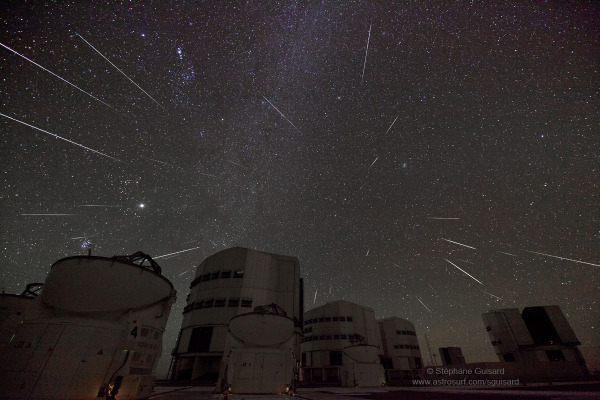 Image credit: Stéphane Guisard (Los Cielos de America), TWAN, via http://apod.nasa.gov/apod/ap121215.html.
Image credit: Stéphane Guisard (Los Cielos de America), TWAN, via http://apod.nasa.gov/apod/ap121215.html.
From Steve D: "The two most overhyped celestial events are meteor showers and comets. 120 meteors per hour sounds impressive but it’s one every thirty seconds. Whee! One, two, three….thirty, rinse, repeat. Unless the count is reliably expected to be in the thousands these shouldn’t be in the popular media, ever."
I've never actually met someone who went out to a dark sky site on a clear night, took in the views of the stars, galaxy, and whatever else happened to be in the night sky, and complained that it wasn't worth it because there wasn't a meteor storm. I mean, I went out for the Camelopardalids earlier this year and didn't see a single one, but sometimes, that's what you get with meteor showers.
But some people did get to see quite a show from the Geminids this year; here's a shot from Lynton Brown in Australia.
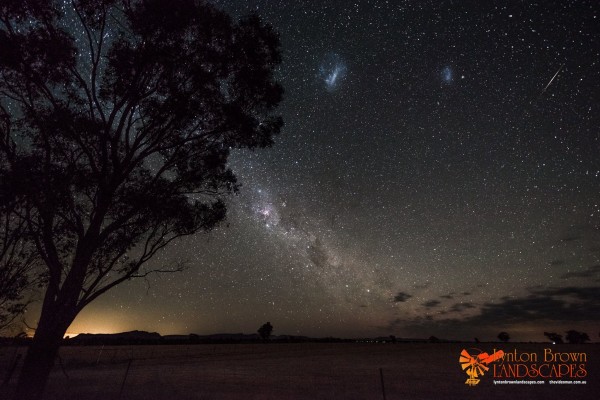 Image credit: Lynton Brown from Horsham, Australia, via http://earthsky.org/todays-image/see-it-best-photos-of-2014s-geminid-me….
Image credit: Lynton Brown from Horsham, Australia, via http://earthsky.org/todays-image/see-it-best-photos-of-2014s-geminid-me….
Here's what Lynton had to say about it, by the way:
“I took several 30 sec exposures over a 10 minute period, meteors were in every shot but this was one of the brighter streaks.”
So yes, it was a good show. I didn't get one, myself; the skies were overcast all night where I am. (And still are today.)
And from Ildayo about the danger to ISS astronauts: "In your post you mention that the ISS crew will have a great view of these meteorites. Shouldn’t they be more concerned about coming into contact with one given the number of particles is increasing every year? What does NASA do to combat an issue like this?"
This is correct; even though the views from the space station can be spectacular during a meteor shower, the station is at an increased risk of punctures. There really isn't anything to do other than build a strong, thick hull (which they have), recognize that the risks are still small but non-zero, and -- in case of emergency -- have methods to patch the station and, if all else fails, an evacuation plan.
Most holes that are put into spacecraft by meteors are microscopic, and the larger ones almost always hit the ISS's solar panels if they're going to hit anything. But a large one could pose a significant threat to humans on board, and so there is the plan of having a Soyuz module for emergency evacuations if need be.
They've never had to use it, but yes, it is a legitimate risk!
Image credit: ESA/NASA, of Andre Kuipers, via http://www.esa.int/spaceinimages/Images/2014/05/Andre_Kuipers_water_dro….
From Agnes on water in space: "Why would water freeze quickly in space? I thought a vacuum was a good insulator, as in Thermos bottles. It seems to me a warm liquid introduced to outer space will slowly cool as it radiates heat, just as coffee slowly cools in a Thermos bottle."
In fact, this is why white dwarf stars remain hot for so long: they're hot, dense and small, and they can only radiate heat very slowly into the vacuum. It's estimated that a white dwarf formed today will remain at thousands of degrees for some 10^14-to-10^16 years, or thousands of times the present age of the Universe.
But for a small amount of water in space, Michael Kelsey gave the best answer, one that needs no further elaboration from me:
It’s the surface-to-volume ratio. If you’re picturing a big blob of water (like a pot-full), then you’re right, and that’s what Ethan described: The pressure drop affects the whole volume, so the water starts to boil (its own heat is above the boiling point at zero pressure) everywhere at once. That boiling essentially “explodes” the big blob into a huge number of tiny droplets.
Those tiny droplets are almost all surface, so they radiate away their heat (not conduct, but radiate in the infrared) and freeze/crystallize as “snowflakes.”
Hence Ethan’s answer: water in space boils _and_ freezes.
And finally, from G on the Universe's fate: "I have a question: How long do we expect to have viable stellar energy sources in our local group?"
Ah, the happy questions. I did a run-thought of some events in our far future back in January which you may enjoy, but for viable stellar energy sources, the lowest-mass stars that are alive now will have a lifetime of around the 100-to-200 billion year figure that the BBC gives.
But!
We are not done forming stars, not by a long shot. The local Universe is still about 70% hydrogen gas by mass, which is tremendous considering it was about 75% hydrogen when the Universe was first born. We will still be forming new stars through mergers of failed stars, late-time-triggers star formation and extremely slow collapse of clouds for likely 10^14 years or so. The longest-lived red dwarfs will still live around 100 trillion years, but brown-dwarf mergers will lead to new red dwarfs for perhaps much longer timetables. White dwarfs will remain around for the longest, as they take a very long time to cool.
And so I would bet we could hold out for longer if energy were the only limiting factor by about a factor of 10-to-100 than the BBC article predicts.
Thanks for a great week of comments, and I'll see you back here tomorrow for even more about the Universe!


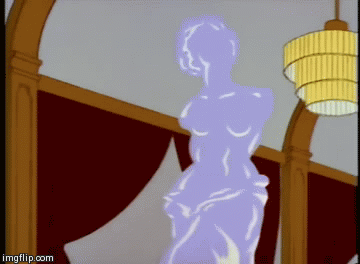

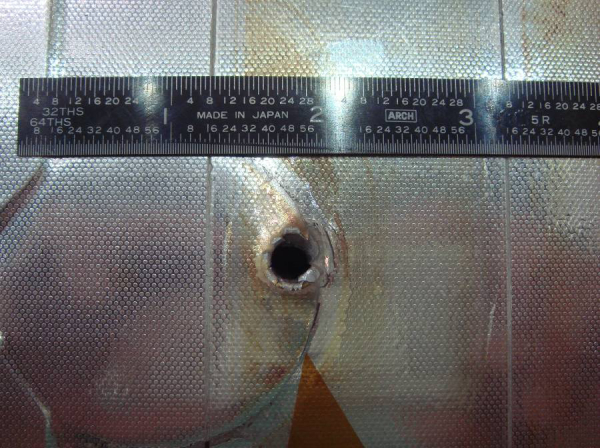

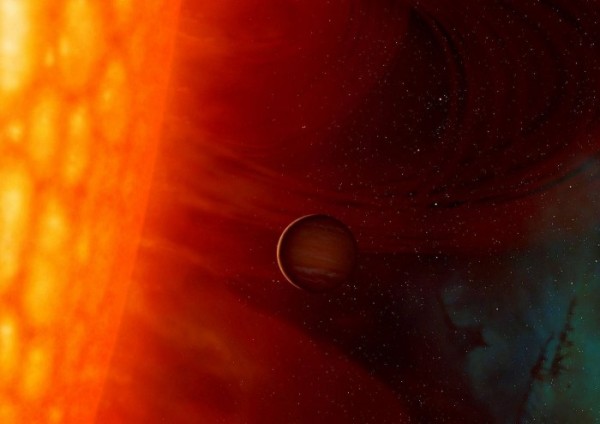

Thanks, Ethan;-)
Looking at the BBC timeline (I keep a copy on my desktop), it says:
"100 billion years: Local group galaxies start to merge."
One trillion years: Local group finishes merging. Also, end of star formation. Earliest estimate."
"100 trillion years: All stars will have died; only objects left are remnants: white dwarfs, neutron stars, black holes."
But there's a contradiction in BBC: At 100 trillion years there's an entry "End of star formation. Lowest estimate for the end of stellar birth." I think that should have been "highest estimate for the end of stellar birth." (see also the entry at one trillion years)
If as you say, 100 trillion years for red dwarfs, and 10 to 100 times the BBC estimate, then there's some convergence: BBC says 100 trillion years = end of star formation, you say another 10 to 100 times that, gets us to somewhere between 1 and 10 quadrillion years (assuming our present consensus cosmological models are correct and we don't have a Big Rip at 20 billion years).
The point of which is:
This is how long technologically capable intelligent life can expect to live in our universe.
Compare 1/2 billion years until Earth becomes uninhabitable due to solar expansion, to 1 quadrillion years if we succeed at becoming an interstellar civilization.
500,000,000 years
vs.
1,000,000,000,000,000 years.
For comparison, assume an optimistic human lifespan of a century. How would you like to live 200 million years instead? That's the magnitude of the difference between going extinct when the Sun cooks the Earth, vs. spreading to the cosmos.
That's the point of the exercise: to show the potential if we succeed at space travel and succeed at interstellar civilization. Once we make the first leap, we can keep doing it again and again. And from there, the ability to do macroengineering projects such as Dyson rings to beam power to rogue planets, becomes almost routine: just a matter of organizing on the scale needed to do it.
Mostly, what this requires, is social evolution that's commensurate with the capabilities we already carry around with us in our brains. With our present biological intelligence, and reasonable increases in computer power, we can bridge the gap between physics and engineering.
But before any of this can occur, we have to a) achieve sustainability on Earth, notably dealing with the climate crisis and with overpopulation and overconsumption, and at the same time, b) continue and accelerate our present course of space exploration, as the earliest steps that will lead toward a long life among the stars.
The things we can do that will make life better for all of us as individuals in the present era, are convergent with the things we can do that will make possible the longevity of Earth-originated life in the cosmos.
So as you see, it was in fact a happy question.